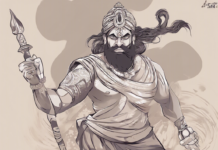Introduction
Karwa Chauth is a traditional Hindu festival celebrated by married women across North India, especially in states like Punjab, Haryana, Rajasthan, and Uttar Pradesh. This festival holds immense historical and cultural significance, as it is considered a symbol of marital bliss and longevity. The festival falls on the fourth day after the full moon in the Hindu lunisolar calendar month of Kartika, which usually corresponds to October or November in the Gregorian calendar.
Historical Origins
The historical origins of Karwa Chauth can be traced back to ancient Hindu scriptures and folklore. One popular legend associated with this festival is the story of Queen Veervati. It is believed that Veervati was the only sister of seven loving and caring brothers. After her marriage, on her first Karwa Chauth, she faced great distress due to thirst and hunger from fasting the entire day. Concerned for her well-being, her brothers created a mirror in a tree that gave her the illusion of a moon, which convinced her that the moon had risen, and she could break her fast. However, as soon as she ate, she received the news of her husband’s sudden death. Heartbroken, she rushed to her husband’s palace, where she met Lord Shiva and Goddess Parvati. The divine couple explained that her husband had passed away due to her incomplete fast on Karwa Chauth. Veervati then observed a strict fast on Karwa Chauth to bring her husband back to life.
Cultural Significance
Karwa Chauth is not just a religious festival; it also holds immense cultural significance in Indian society. It is a celebration of the bond between a husband and wife, symbolizing love, commitment, and sacrifice. Married women observe a day-long fast without food or water for the well-being and longevity of their husbands. The fast is broken only after sighting the moon and offering prayers for the husband’s prosperity and long life. The festival also strengthens the familial ties between a woman and her in-laws, as mothers-in-law often gift their daughters-in-law sargi, a hamper of fruits, sweets, and other delicacies to eat before sunrise to help them sustain throughout the day.
Rituals and Traditions
The rituals of Karwa Chauth vary slightly from region to region, but the core essence remains the same. Women wake up early before sunrise to partake in the sargi given by their mothers-in-law. They wear traditional attire, apply henna, and adorn themselves with jewelry, signifying suhagan (married) women. Throughout the day, they abstain from food and water, spending time with other women in the community, exchanging gifts and stories. In the evening, they gather for the puja (prayer ceremony) where they worship Lord Shiva, Goddess Parvati, Lord Ganesha, and the moon. The fast is broken after offering prayers to the moon, followed by a sip of water and the first morsel of food by the husband’s hands, marking the end of the auspicious day.
Modern Relevance
In contemporary times, Karwa Chauth has evolved beyond its traditional roots and found resonance in urban societies as well. While the essence of the festival remains the same, with women observing the fast for their husbands’ well-being, the celebration has witnessed modern adaptations. Many working women participate in Karwa Chauth festivities, balancing their professional commitments with cultural traditions. Additionally, the festival has become a symbol of love and solidarity, with couples often mutually fasting or finding creative ways to celebrate together, irrespective of gender.
Social Impact
Karwa Chauth plays a significant role in reinforcing the societal construct of marriage and family values in Indian culture. It exemplifies the devotion and love that a woman has for her husband, transcending the mundane aspects of daily life. The festival fosters a sense of togetherness and community among women, as they come together to celebrate womanhood and marital relationships. It also serves as a reminder of the sacrifices made by women in upholding familial harmony and traditions, reflecting the deep-rooted cultural ethos of India.
FAQs about Karwa Chauth:
- What is the significance of applying henna on Karwa Chauth?
-
Applying henna is considered auspicious and symbolizes marital happiness and well-being. It is an age-old tradition followed by married women during festivals and ceremonies.
-
Can unmarried women participate in Karwa Chauth?
-
While Karwa Chauth is primarily observed by married women, unmarried women can also partake in the festivities to pray for their future spouses or to seek blessings for their loved ones.
-
Is fasting mandatory for all married women on Karwa Chauth?
-
Fasting on Karwa Chauth is a voluntary act of devotion and love. While many women choose to observe the fast, it is not mandatory for all married individuals.
-
How has the celebration of Karwa Chauth evolved over time?
-
Over the years, Karwa Chauth has witnessed modern adaptations, with women balancing traditional rituals with contemporary lifestyles. The festival now resonates with a broader audience, transcending cultural boundaries.
-
Are there any regional variations in the way Karwa Chauth is celebrated?
- Yes, the rituals and traditions associated with Karwa Chauth may vary across different regions in North India. Each community adds its unique customs and practices to the festival, enriching its cultural tapestry.





